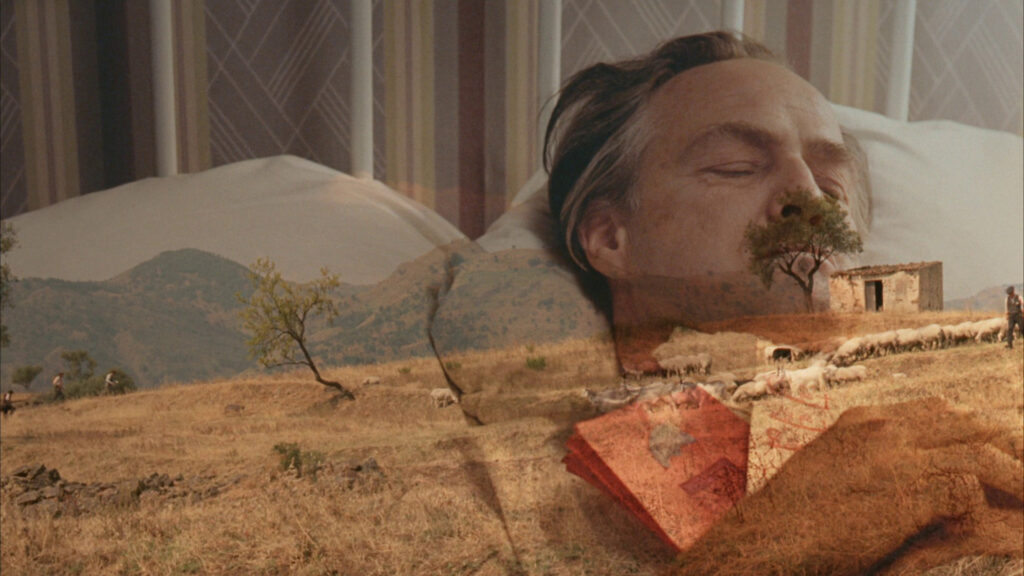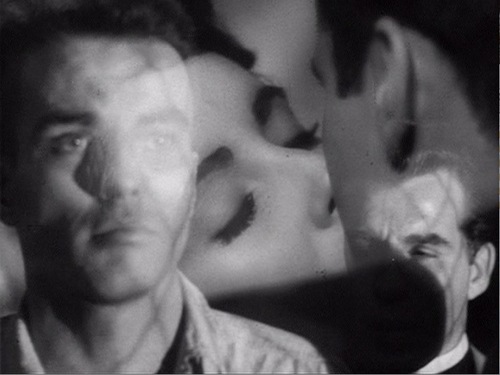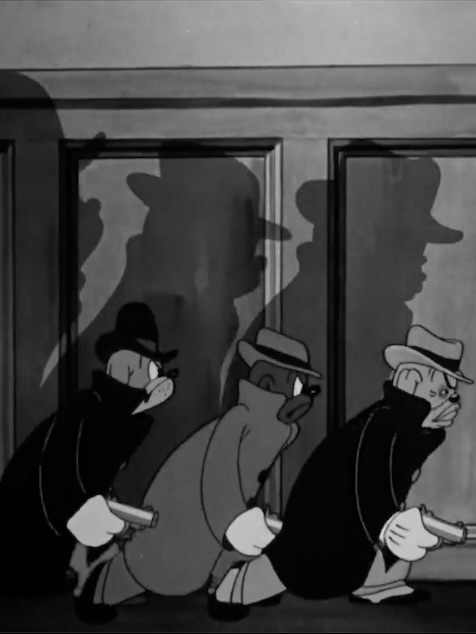
The Art of the Dissolve
“A good dissolve turns water into wine, prose into poetry.”
A dissolve is a device used to transition between sequences. It is where one image starts to fade out while the next image begins to fade in. In the middle of the dissolve, the two images will instantaneously combine, forming a single composition.
Below is an example from ‘The Godfather‘. Marlon Brando lies in a hospital bed dying. Coppola (the director), dissolves from a close-up of Don Corleone’s face, to a long shot of the Sicilian countryside: his place of birth. As the former image ‘dissolves’ into the latter, an olive tree takes the place of Don Corleone’s facial hair and, for a moment, the tree becomes his moustache. Now, this may seem almost a trifle farcical to you, and perhaps it is, though I might add that the scene itself is anything but. In addition, the argument could be made that the land of Don’s home (the tree) is as much a part of him as the literal hair growing above his lip, although, I care not for that reasoning since a dissolve needs no such justification. With that being said, this example remains one of the most valid reasons to use a dissolve because, on a most basic level, it adds visual interest.

The first known use of the dissolve was surprisingly early on, in 1899, during the film ‘Cinderella‘. It was also the first movie comprising of more than one single scene, and director ‘Méliès needed ways to transition between the six different sequences. Hence, it was necessary to invent a way to signal to audiences, still incredulous with the fact that the pictures on the screen were moving, that in-between the different scenes, a change in time and place had occurred.
By the 1900s, when most of the grammar used in films and television today was being invented, the dissolve began to be utilised with decreasing frequency. The artistic zenith of this miraculously distinguished editing device was around the middle of the twentieth century, with Orson Welles using it to tremendous effect in his 1941 debut, ‘Citizen Kane‘, and two of my personal favourite examples came ten years later, in George Stevens’ ‘A Place in the Sun’. Since then, the dissolve has been dragged through the dark ages, and has made somewhat of a return to fashion in a bastardised form. In the world of the graceful dissolve, a world in which I long so dearly to live, it seems we have regressed.
Even if you are unfamiliar with the term, or are scratching your head wondering if and when you have seen one of these before, i can assure you, that you have. Dissolves are a part of filmic grammar and, in a sense, work similarly to conjunctives in literature. Unlike grammar, it is doubtful that you will have been taught visual literacy explicitly. But, by being bombarded with moving images since the day you were born, subconsciously you will have learnt to understand elements of this visual grammar, and understand what devices such as dissolves mean within the context of the motion picture you are watching.
So why use a dissolve, and why have they been dumbed down to two main functions? I cannot, of course, answer the latter question, but I will try and underline the ways in which one might employ a dissolve today, and, in highlighting a few of my favourite examples in cinema history, wax lyrically about their effect when placed in the right hands.
In general, dissolves are becoming less and less common, and while I haven’t watched any blockbuster movies since I was about eight, I can’t imagine many of them utilise such exquisite transitions, but, if they did, it would probably be to show the passing of time.
This has become the most frequent use of the dissolve today. At this point, it really is an affront to your intelligence as an audience: night fades into day, day into night, etc. These dissolves are usually (mis)handled like establishing shots (used to establish location), and offer no dramatic impact, merely reminding the viewer that day follows night, night follows day, and this is the cafe this scene is about to take place in.
This can be done within scenes too: the charming husband announces that he is leaving for the pub to see his friends, dissolve, and we see him knocking on the door of his mistress’s house. Time has elapsed for him to leave his family, journey to his destination, and the dissolve signals that. The strictly utilitarian nature makes these transitions largely uninteresting visually, pack no emotional weight, and again, allow for no dramatic interpretation. Using them in this manner is akin to writing a novel on love and lust using the language of a six year old. Should these dissolves have visual appeal, then their use is entirely justified. In fact, it’s encouraged.
The second most common use of the dissolve, is to enter into the mind of a character. Imagine being very physically close to the leading lady’s melancholy face, looking longingly out the window as the rain beats down, then slowly dissolving to a scene in the beaming sunshine, on a beach, as she rolls around on the sand with the first boy she ever loved. The employment of the dissolve here, along with her facial expression in the prior image, would let you know that this is what she is thinking about, a moment from the past that she is re-living.
This method absolutely has its merits, and can be used to tremendous effect. However, it is easy to get wrong. The desired effect here is primarily emotional, and therefore the moment itself must have emotional weight. Any time emotions are involved, hands of lesser skill are liable to botch the job. In such hands, this dissolve becomes tawdry.

To the left is an example of this from 1951’s, ‘A Place in the Sun’. Montgomery Clift stands left of frame, with the priest behind and to his right, bestowing a final prayer upon him, as Clift waits to be taken to the electric chair. Superimposed (so technically not completely dissolved) is an image from earlier in the film, of Monty kissing the love of his life, Elizabeth Taylor, whom he is never to see again. We see, in the characters’ precious final moments, what it is that he lived for. This works for two reasons. Firstly, because of the visual link. Clift’s character (George) literally shares the frame with the memory he is revisiting, and we get to see the two moments in time simultaneously. The second reason follows on from the first: because the two images share the space, what George is seeing in is head as he looks into the distance off camera, is superimposed into his eye line. As he looks directly at the past, the correlation between the two moments is unmistakable.
I shall move on, now, to a pair of examples that I feel illustrate the inimitable beauty of the dissolve.
In Charlie Chaplin’s ‘City Lights‘, a lonely Charlie (as The Tramp) meets Virginia Cherrill’s character, who is blind, beautiful, and sells flowers. It is she that Charlie is to fall dreadfully in love with. He is smitten with her upon first sight. The task here is to communicate, immediately, that this is the girl. Before she even says a word, we need to know who she is and what she will mean both to Charlie and to the story, such that we feel about her exactly the way that The Tramp will. So, Chaplin (as director) employs the cross-dissolve, moving from a close-up of a bouquet of flowers to a close-up of the girl’s face. Now, what is necessary here for this to work, is the audience’s cognisance of the inherent symbolism in flowers, and their connotations of love, and beauty. Since this symbolism is fairly universally understood it becomes clear, with the dissolve between the two shots, that Chaplin is drawing parallels between the two images.

The effect of Chaplin’s dissolve is as intellectual as visual, since the girl simply takes the place of the flowers on screen, and the images don’t line up in an especially creative way. Nor is it chiefly emotional, since we don’t yet know the girl – though the ultimate result is of course emotional. The dissolve here works like a line, drawing your eye from one image to the other as you focus on the new image as it replaces the old one, indicating that there is a link between them. A straight cut here could be either confusing, because the two disparate images would be show separately; equally it may seem too obvious, because there is no subtlety or grace in a straight cut. With the dissolve we see the two images together, within the same frame, with the right balance of subtlety and ‘crudity’, such that the desired effect is subconsciously achieved.
As a side note I would like to add that I am not of the opinion that the two images combine unappealingly. A beautiful woman and a bouquet of flowers sharing the screen is as gorgeous as it sounds: it’s only that the images themselves do not match up in a particularly pleasing way. Had the petal of a flower dissolved into Virginia Cherrill’s eye… Well, then… any use of the dissolve would have long since become an exercise in futility.
My last, but by no means least, dissolve of note, comes from Douglas Sirk’s 1955 melodrama, ‘All That Heaven Allows‘. (This is, of course, by no means an exhaustive list). In my opinion this is a dissolve that fires on all cylinders.
The scenario is as follows: Jane Wyman’s character, Cary, lives in a respectable, proper, mid-century New England. She is widowed, and eventually falls in love with a working class man, Ron (Rock Hudson), who is something of a neighbourhood gardener. Cary’s own neighbours, friends, and family, object to her being with someone of a lower class and the societal and familial pressures force Cary to make a choice between the life she lives, and him. And so we find ourselves in the middle of the movie, with Cary’s own children threatening to disown her, if she doesn’t give up Ron.

We leave a scene of Cary telling Ron of the decision she faces, a decision in which we feel she will choose wrongly, and dissolve into the following scene, of Cary walking down the small town streets, alone, in a crowd of people. Visually, the dissolve tells the whole story. The square supports of the floor-to-floor windows in Ron’s countryside cabin become bars, distancing and blocking Cary of the next scene from what she wants most. Wyman’s character on the right of the frame, in the latter image, is looking at herself with Ron, through the bars, bars put up by the people she loves, bars that imprison her. The emotional weight of the situation props up the dissolve with aplomb, it works especially well visually, and in a nutshell visually dramatises the entire conflict of the movie.
In one single transition, you have an image that says it all. And to think, that that is all this is, a transition between scenes. To this day I maintain that whomever it was that talked of dissolves, prose, poetry, water and wine, all in the same sentence, was someone who knew things that us mere mortals, can but merely guess at.
You may also like
A LOVE FOR ALL TIME: FEBRUARY
“I don’t want you to go away. I just said that. You go if you want to. But hurry righ
The French Dispatch
Tellus integer feugiat scelerisque varius. Sit amet volutpat consequat mauris nunc congue nisi. At u
A GANGSTER’S PARADISE: JUNE
“A cartoonist’s only commandment should be: Thou shalt not bore.” – Tex Aver




